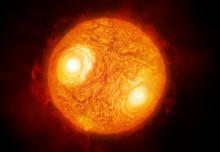Listen to today's episode of StarDate on the web the same day it airs in high-quality streaming audio without any extra ads or announcements. Choose a $8 one-month pass, or listen every day for a year for just $30.
You are here
Moon and Antares
Compared to most of the stars in the galaxy, our Sun is a giant. It’s bigger and heavier than perhaps 90 percent of the stars in the Milky Way. It’s so big that you could fit more than a million Earths inside it.
Yet when it’s compared to some of the biggest stars of all, the Sun is a mere bit of cosmic flotsam — like a BB compared to a bowling ball.
A prime example is Antares, the leading light of Scorpius. The bright orange star is close to the lower right of the Moon as they climb into good view by midnight, and directly below the Moon at first light.
Antares is at least 15 times as massive as the Sun. That great heft squeezes its core far more tightly than the core of the Sun. That boosts the core’s temperature, which revs up the nuclear reactions that power the star. The radiation from those reactions pushes outward, making the star’s outer layers puff up like a giant hot-air balloon.
The result of all of this is that Antares is hundreds of times wider than the Sun. In fact, if it took the Sun’s place in our own solar system, it would extend beyond the asteroid belt, engulfing Earth and the other inner planets.
That’s an astounding volume of space — more than 100 septillion cubic miles — a one followed by 26 zeroes. Or to look at it another way, this supergiant star is big enough to swallow several hundred million Suns — a monster star on any scale.



